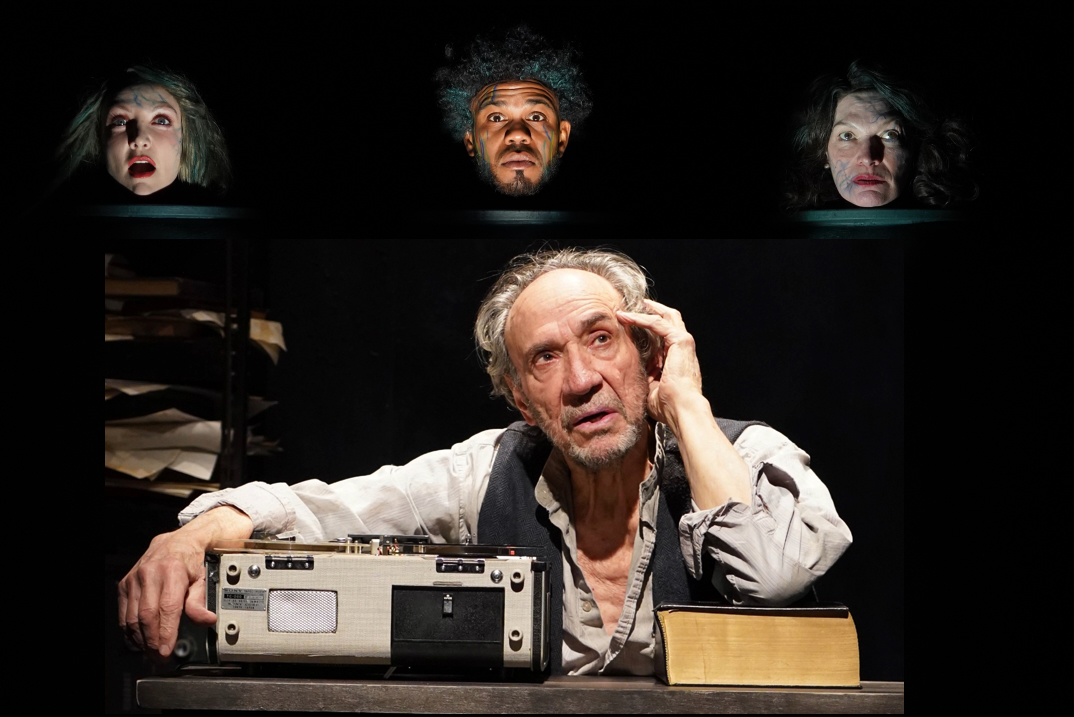BECKETT BRIEFS
(From the Cradle to the Grave)
Not I, Play and Krapp’s Last Tape
Directed by Ciarán O’Reilley
Featuring F. Murray Abraham, Roger Dominic Casey,
Kate Forbes and Sarah Street
Irish Repertory Company
Reviewed by David Spencer
you might have to be to some degree into Beckett or what Beckett’s into…some what degree somewhat degree…how much greedy degree…for the, what, the abstractions to gain traction, attraction-traction, upon HEARING…at the speed the speed the spoken speed…but a sense an essence what is essentially an impish no not impish HEARING an impression a precious impression because otherwise it races along, a long stream of conscious unconscious WORDS WORDS HEARING…(repeated motives but what’s my motivation) and sans context, the sans of time, you may well water well-water be at sea…
I was going to write the entire review like that, but a sustained Beckett parody—even one affectionately intended—takes a lot of energy and needs to be better than mine, which is only superficial. But perhaps that’s enough to make the point. Samuel Beckett is an absolutely necessary theatrical voice. His approach to minimalism, reductiveness, themes that are both specific and ambiguous, language that simultaneously celebrates clarity and obfuscation, is a seminal influencer. Whether it’s necessary for you in all its iterations is another, very individualistic matter.
His longer pieces, like Endgame and Waiting for Godot—when done well, and there’s a topic for another discussion—give an audience “indoctrination time.” You may dig his imprimatur or not, but you won’t come away not having understood, at least in a general sense, the game. Whereas with the three short pieces in Beckett Briefs at the Irish Rep, you’re mainlining from the first moment.
And both of the first two plays honor Beckett’s intentions of speed, syllabic emphasis, sudden outburst, sudden pause, use of hypnotic monotone. Individual mileage may vary, but if you don’t know going in—
—that Not I, which shows you only a mouth for ten minutes, is about an elderly woman who has been silent all her life and finally found her voice…
—that Play, which has two women, wife and mistress, on opposite sides of a man, husband, all in urns, in the afterlife, still trying to work out the reverberations of an extramarital affair…
…you may well be lost. Not bored. But lost, unable to grasp the context whizzing by.
I was.
Then after I got home, I Googled the contexts, and then zipped overt to YouTube, figuring there would be at least two famous filmed iterations of each play, no doubt featuring British stars with renowned classical chops, and sure enough, there were—and now armed with the context and the intimacies of cinematic treatment, I was able to say…”Oh.” And consider what I’d seen live on stage in retrospect.
And I can tell you that the performances of Sarah Street (in the first two plays) plus Roger Dominic Casey and Kate Forbes (who join her in the second) are every bit as virtuosic as those I saw filmed, in their command of both character and technique. And I don’t just mean acting technique. I mean the challenges of Beckett, which embody a technique almost unto itself, save that the actor must absorb it into his or her toolkirt.
As to the third play, Krapp’s Last Tape…well, its longer form does give you that indoctrination time. And it’s a play I knew relatively well, having seen all or excerpts of many versions on YouTube, featuring renowned actors of the ensuing generations (it debuted in 1958)…and a new viewer wouldn’t take long to understand that it’s about an old man reviewing his life, via reel-to-reel taped recollections—who is today adding a new one. At the Irish Rep, the one act features F. Murray Abraham. An actress I’m friends with, who worked with him on Broadway in Angels in America, in which he replaced Ron Liebman as Roy Cohn, said of him, unforgettably, “he had [the role] in his back pocket.” Meaning it was just there, naturally. Or seemed to be.
Beckett, of course, takes a different kind of concentration—and Krapp is the opposite of the roles that precede it. He’s ruminative, grasping for meaning, often not speaking at all, sometimes just listening to himself on tape, being ruminative, grasping for meaning. And—despite any challenge and investigation that may have been part of Abraham’s rehearsal process (or maybe because of it)—along with the age, long experience and idiosyncratic career that must resonate with all of Krapp’s highs, lows, pleasures and regrets—this role seems very natural to him as well.
As to Ciarán O’Reilley’s direction: Like his actors, he’s bound to the demands of Beckett technique, and to that extent, his distinctive contribution is almost invisible; it has been his job to find, and then guide the design team and his actors through a process of—as Stravinsky famously called it—freedom within restriction. And that he seems to have done.
And like him and his comrades-in arms, whether you find the same within its 70 minutes may depend upon how prepared you are to see it. Or reflect upon it later…
